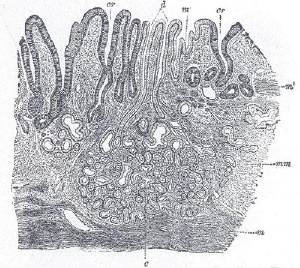Aug 20 2008
Chemical engineers from Johns Hopkins University have broken the "mucus barrier," engineering the first drug-delivery particles capable of passing through human mucus - regarded by many as nearly impenetrable - and carrying medication that could treat a range of diseases. Those conditions include lung cancer, cervical cancer and cystic fibrosis, the research noted in a presentation scheduled for the 236th National Meeting of the American Chemical Society.
 An illustrated cross-section of human mucus membrane from the stomach. Credit: Henry Gray's Anatomy of the Human Body.
An illustrated cross-section of human mucus membrane from the stomach. Credit: Henry Gray's Anatomy of the Human Body.
"We studied the properties of disease-causing viruses that evolved to infect mucosal surfaces to engineer a coating that enables our drug delivery particles to penetrate mucus layers in minutes. In our new work, we have improved the coatings considerably to allow faster penetration for a wider array of particle sizes," says lead presenter Samuel K. Lai, Ph.D.
Mucus, the slippery secretion lining the lung airways, surface of the eye, gastrointestinal tract, and female reproductive tract, may seem delicate. But it is a tenacious barrier, effectively keeping out most pathogens and limiting infections.
"Mucus has evolved to be a highly efficient barrier," says Justin Hanes, professor of chemical & biomolecular engineering at Johns Hopkins University, the lead investigator of the study. "For example, we constantly inhale particles into our lungs, but they typically stick to mucus rather than penetrate it. Particles that stick are removed rapidly from the lungs on a mucus 'conveyor belt,' and are swallowed and sterilized in the gut. Mucus barriers protect us from constant infection, as well as everyday things like the millions of particles in the black cloud emitted from a bus when it takes off from a stop."
Unfortunately, mucus also prevents the passage of many beneficial drugs. And when the mucus gets thicker — most notably in diseases like chronic sinusitis, cystic fibrosis and chronic obstructive pulmonary disorder — drug treatment of the lungs and other mucus-lined areas becomes more difficult.
Lai explained that coating drug-loaded nanoparticles with an inexpensive polymer material allows particles to pass through the mucus linings. With this mucus-penetrating mechanism, drugs could be delivered locally and with enhanced durations to treat diseases at mucosal surfaces. In collaboration with Richard Cone, professor of biophysics at Johns Hopkins, the work also opens the door to more targeted drug delivery – including improved chemotherapy for cervical and lung cancer patients.
For inspiration in their quest to breech mucus, Hanes and colleagues took a lesson from Mother Nature — specifically viruses capable of infecting mucosal surfaces. Some of these viruses were able to pass through the dense, net-like mesh of mucus as if it were water.
The researchers found that the spaces between the "threads" of the mucus mesh were much larger than previously thought, providing an opportunity for drug particles that do not adhere to mucus to pass through and avoid rapid clearance .
"If a particle is small enough and not adhesive, then it can get through the mucus net – that's how some viruses penetrate mucus barriers," says Hanes.
The team found that a polymer known as polyethylene glycol, or PEG, could coat individual drug particles and imbue them with the same properties as these mucus-breeching viruses. "PEG is one of the most widely used polymers for therapeutic applications," Lai explains. It's an FDA approved polymer that's been in use in humans for over 25 years – it's known to be very safe."
By encapsulating drugs in mucus-penetrating particles, drug companies could expand the realm of treatment options for many diseases. "For example, cervical cancer patients could locally apply chemo drugs inside mucus-penetrating particles, which would then deliver the drug locally in the female reproductive tract at efficient concentrations over prolonged periods of time, instead of delivering it everywhere else in the body. That could drastically reduce the side effects as well as prolong the presence of drugs at the target site," says Lai.
And in the case of patients with cystic fibrosis —which causes thick mucus buildup in the lungs — mucus-penetrating drugs could create more effective therapies to fight the disease. This could improve the quality of life for 70,000 cystic fibrosis sufferers worldwide.
"Eventually, we seek to engineer systems where a drug could be delivered to a specific tissue or set of cells anywhere in the body – we want to make that possible."